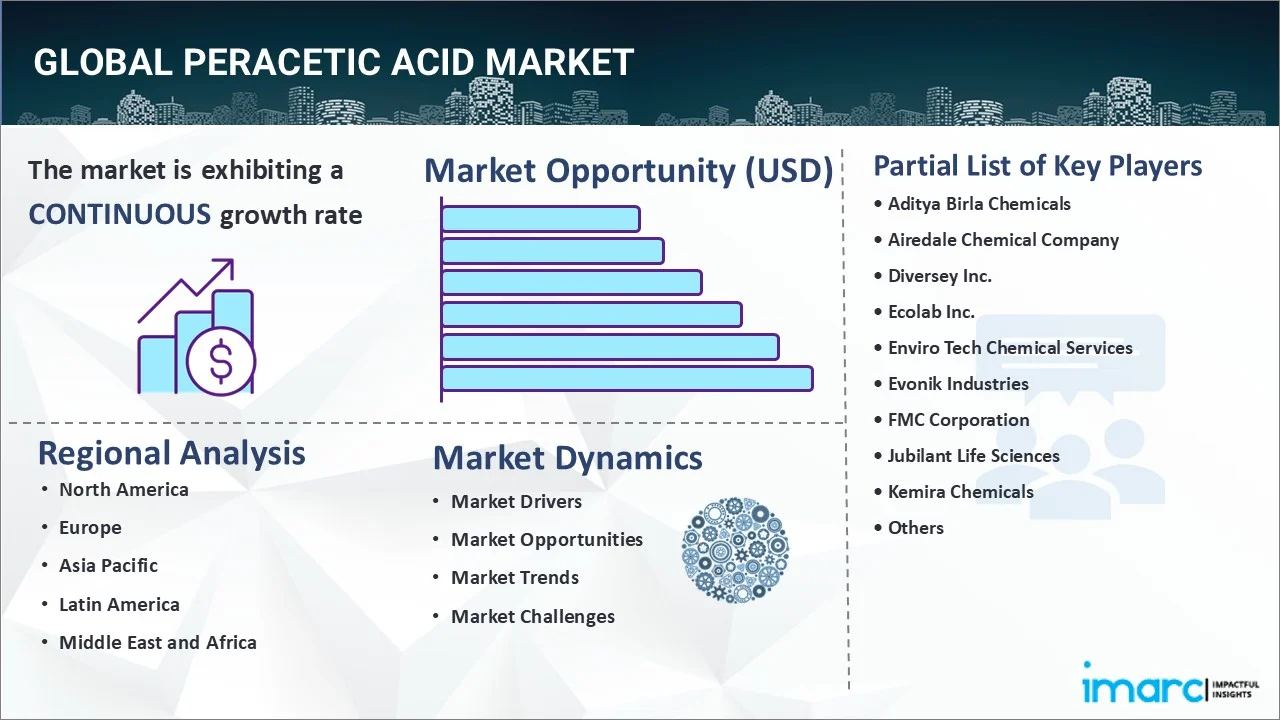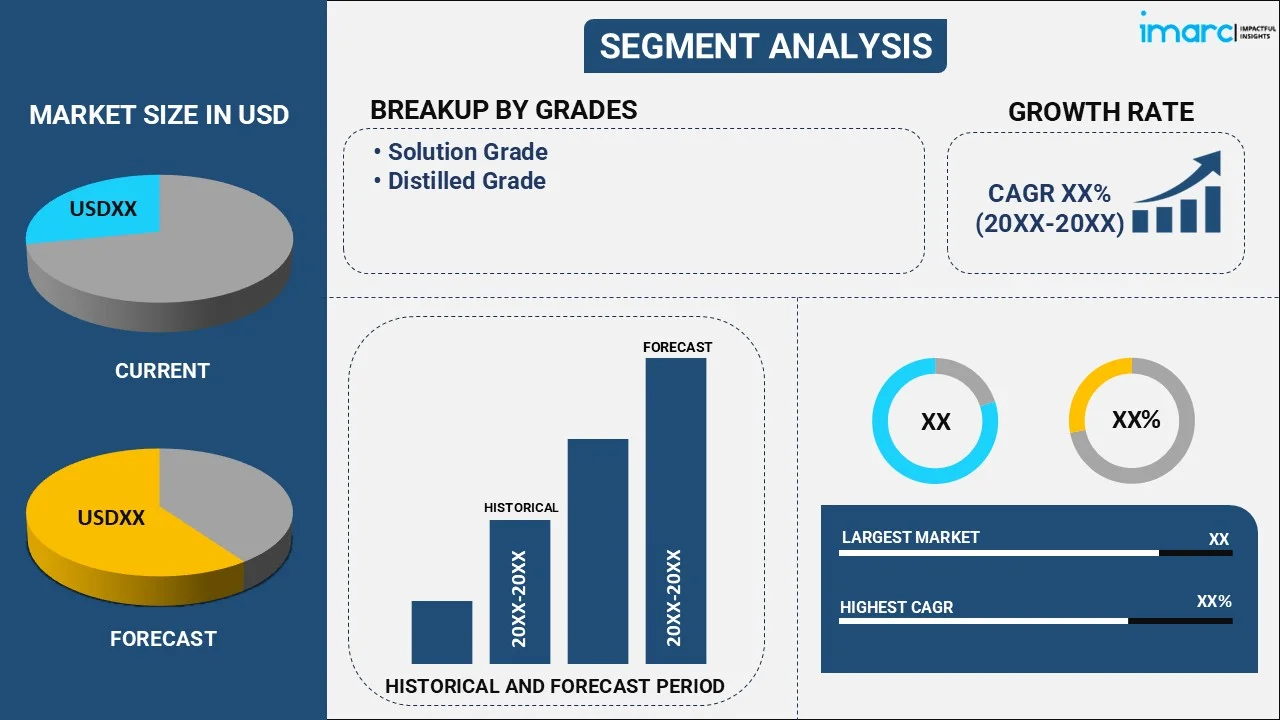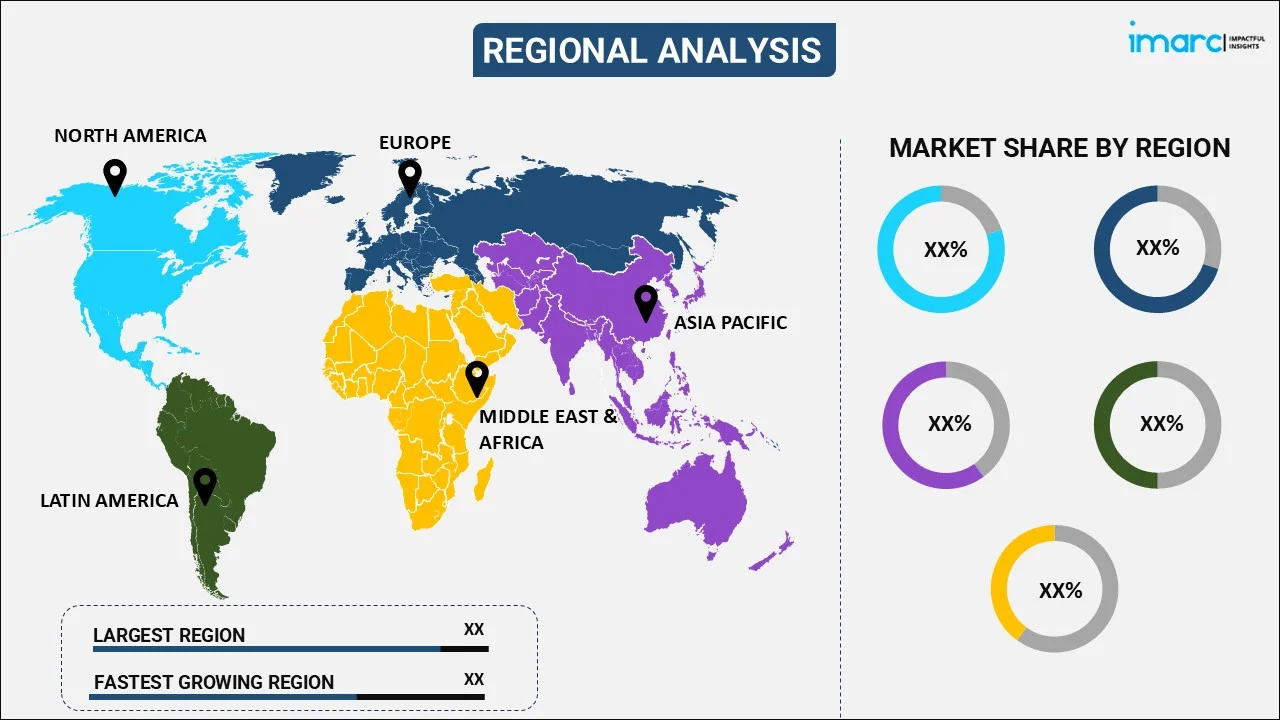
Peracetic Acid Market Report by Grade (Solution Grade, Distilled Grade), Application (Disinfectant, Sterilant, Sanitizer, and Others), End-Use Industry (Healthcare, Food & Beverage, Water Treatment, Pulp & Paper, and Others), and Region 2026-2034
Peracetic Acid Market Size:
The global peracetic acid market size reached USD 1,113.1 Million in 2025. Looking forward, IMARC Group expects the market to reach USD 1,927.0 Million by 2034, exhibiting a growth rate (CAGR) of 6.29% during 2026-2034. The market is predominantly driven by the heightening chemical demand in key industries like wastewater treatment, food safety, and healthcare due to its exceptional disinfection attributes and environmentally friendly nature. Moreover, increasing regulatory aid and environmental concerns is also supporting market expansion.
|
Report Attribute
|
Key Statistics
|
|---|---|
|
Base Year
|
2025
|
|
Forecast Years
|
2026-2034
|
|
Historical Years
|
2020-2025
|
|
Market Size in 2025
|
USD 1,113.1 Million |
|
Market Forecast in 2034
|
USD 1,927.0 Million |
| Market Growth Rate 2026-2034 | 6.29% |
Peracetic Acid Market Analysis:
- Major Market Drivers: The market is chiefly driven by the increasing demand in industries such as healthcare, water treatment, and food processing due to its exceptional disinfection abilities. Its biodegradable and eco-friendly profile aligns with rising environmental concerns, further boosting product demand. In addition, regulatory assistance from administrative bodies endorsing sustainable disinfection chemicals has fostered its extensive adoption. Moreover, escalating awareness regarding hygiene and sanitation, particularly in the post-pandemic landscape, also spurs market expansion. The dynamism of peracetic acid in mitigating broad range of sanitation issues makes it an ideal choice in numerous industries.
- Key Market Trends: The magnifying utilization of the chemical in sectors such as food processing and healthcare, coupled with technological innovations in chemical formulations, are key trends significantly contributing to a positive peracetic acid market outlook. The need for biodegradable and sustainable disinfectants is currently escalating, with peracetic acid rapidly gaining momentum because of its minimal impact on the ecosystem. In addition, the inclination toward non-toxic, greener substitutes in industrial sanitation further solidifies its market position. Moreover, advancements in storage and packaging methods are improving the chemical’s shelf life, reinforcing its adoption across diverse segments.
- Geographical Trends: Europe is the dominant regional market primarily due to its strict environmental policies and robust industrial base. Countries like the UK, France, and Germany are major contributors, where product demand in predominantly propelled by its versatile applications in healthcare, food safety, or water treatment segments. In addition, governmental organizations of Europe are currently focusing on the utilization of environmentally friendly chemicals, resultantly bolstering the prominence of peracetic acid. The region’s emphasis on hygiene regulations and sustainability across crucial industries fortifies its leadership in the global market.
- Competitive Landscape: Some of the major market players in the peracetic acid industry include Aditya Birla Chemicals, Airedale Chemical Company, Diversey Inc., Ecolab Inc., Enviro Tech Chemical Services, Evonik Industries, FMC Corporation, Jubilant Life Sciences, Kemira Chemicals, Lenntech, Mitsubishi Gas Chemical Co., National Peroxide Ltd., PeroxyChem, Seitz GmbH, Solvay S.A., among many others.
- Challenges and Opportunities: Some of the key peracetic acid market recent opportunities are arising from increased implementation of regulatory policies to leverage sustainable disinfection chemicals, particularly in industries such as healthcare and food. However, various challenges are witnessed in the market, like storage as well as handling complications due to the highly reactive nature of the product. The market also experiences intense competition from alternative disinfectants, which could significantly restrict the market expansion. Despite such challenges, technological innovations in formulations and amplifying awareness among both producers and consumers regarding environmental safety offer substantial prospects for further product expansion in diverse industries globally, with particular emphasis on heightening demand for non-toxic, greener products.

To get more information on this market Request Sample
Peracetic Acid Market Trends:
Increasing Product Demand in Food and Beverage Sector
The global peracetic acid market is experiencing magnified demand within the food and beverage sector, mainly driven by strict safety and hygiene policies. The excellent antimicrobial properties of peracetic acid position it as a preferable chemical for disinfecting equipment and surfaces in food processing units. According to a research article published in May 2023, peracetic acid and its commercial disinfectant formulation demonstrated 3-log reduction (99.9% reduction in viral growth) within 1 minute at 80 ppm and a 4-log reduction (99.99%) within 5 minutes at 50 ppm against murine norovirus 1 on stainless steel surfaces, which are extensively used in the food industry. Moreover, as customer need for hygienic and safe food product escalates, governing bodies are implementing stringent sanitation policies, further bolstering the peracetic acid demand. Its efficacy against variety of harmful microbes ensures its amplifying adoption in this highly regulated industry.
Increasing Demand for Eco-Friendly Disinfectants
The global market for peracetic acid is witnessing significant expansion due to the rising demand for eco-friendly disinfectants across various sectors such as wastewater treatment, food processing, and healthcare. The biodegradable profile and ability to not yield any toxic residues make peracetic acid a preferable option over conventional disinfecting chemicals such as chlorine. As per industry reports, chlorine containing bleach yields harmful organic residues in wastewater and production of these bleaches releases almost 150 million tons of carbon dioxide annually. Moreover, this trend is also supported by regulatory agencies compelling manufacturers to formulate more sustainable disinfectants to minimize the environmental impact. As numerous businesses are currently focusing on adoption greener methodologies, the peracetic acid market growth is expected to fuel significantly in applications demanding eco-conscious and efficient sanitation.
Rising Product Adoption in Wastewater Treatment
One of the key trends in the global peracetic acid market is its accelerating adoption in wastewater treatment applications. Due to its superior oxidizing properties and capability to hydrolyze into non-toxic byproducts, peracetic acid is rapidly emerging as an ideal chemical for disinfecting polluted or wastewater without yielding any detrimental residues. Moreover, this chemical is highly effective against a wide range of microorganisms, including viruses and bacteria, positioning it as a valuable solution in treating industrial as well as municipal wastewater. According to a research article published in the journal Chemosphere in February 2023, approximately 380 trillion liters of wastewater is generated worldwide annually. As governments enforce stringent policies regarding wastewater treatment, the demand for superior disinfectants in anticipated to grow globally, ultimately increasing the peracetic acid market revenue.
Peracetic Acid Market Segmentation:
IMARC Group provides an analysis of the key trends in each segment of the market, along with forecasts at the global, regional, and country levels for 2026-2034. Our report has categorized the market based on grade, application, and end-use industry.
Breakup by Grade:

To get detailed segment analysis of this market Request Sample
- Solution Grade
- Distilled Grade
Solution grade accounts for the majority of the market share
The report has provided a detailed breakup and analysis of the market based on the grade. This includes solution grade and distilled grade. According to the report, solution grade represented the largest segment.
According to the peracetic acid market forecast, solution grade is anticipated to sustain its dominance as extensively utilized form of the chemical, majorly due to its multifunctionality across numerous industrial processes. It is widely leveraged in sanitization and water treatment applications due to its excellent efficacy in eliminating both inorganic and organic contaminants. The effective and stable formulation of solution-grade peracetic acid establishes it as a preferable option for industrial processes demanding superior purity levels. In addition, its capability to function at low concentrations while sustaining its resilient disinfectant attributes has further fueled its demand in industrial and environmental sectors globally.
Breakup by Application:
- Disinfectant
- Sterilant
- Sanitizer
- Others
Disinfectant holds the largest share of the industry
A detailed breakup and analysis of the market based on the application have also been provided in the report. This includes disinfectant, sterilant, sanitizer, and others. According to the report, disinfectant accounted for the largest market share.
As per the peracetic acid market report, peracetic acid is dominantly used in disinfectant applications across critical sectors such as food processing, water treatment, and healthcare. The wide-spectrum antimicrobial activity of peracetic acid against various viruses, bacteria, and fungi positions it as an exceptionally efficient disinfectant. In addition, its eco-friendly profile, yielding no harmful residues, appeals to sectors striving to adhere to strict environmental and hygiene regulatory standards. According to the Center for Disease Control and Prevention, globally, 1.5 billion people lack basic sanitation services while 2 billion are deprived of basic hygiene facilities. Consequently, the focus on public sanitation and health in both emerging and developing economies is rising, further amplifying the requirement for peracetic acid as a credible disinfectant.
Breakup by End-Use Industry:
- Healthcare
- Food & Beverage
- Water Treatment
- Pulp & Paper
- Others
Food & beverage represents the leading market segment
The report has provided a detailed breakup and analysis of the market based on the end-use industry. This includes healthcare, food & beverage, water treatment, pulp & paper, and others. According to the report, food & beverage represented the largest segment.
According to the peracetic acid market overview, the food & beverage sector has emerged as the dominant end-use industry that extensively utilizes peracetic acid in sanitizing surfaces, equipment, and process water, guaranteeing food hygiene and safety. The regulatory approval for its utilization in food-contact surfaces, combined with its efficacy in controlling contamination without altering the food quality, significantly bolsters its demand. In addition, with escalating customer awareness regarding food safety policies, the usage of peracetic acid in the food and beverage sector is anticipated to fuel substantially in the coming years.
Breakup by Region:

To get more information on the regional analysis of this market Request Sample
- North America
- United States
- Canada
- Asia Pacific
- China
- Japan
- India
- South Korea
- Australia
- Indonesia
- Others
- Europe
- Germany
- France
- United Kingdom
- Italy
- Spain
- Russia
- Others
- Latin America
- Brazil
- Mexico
- Others
- Middle East and Africa
Europe leads the market, accounting for the largest peracetic acid market share
The report has also provided a comprehensive analysis of all the major regional markets, which include North America (the United States and Canada); Europe (Germany, France, the United Kingdom, Italy, Spain, Russia, and others); Asia Pacific (China, Japan, India, South Korea, Australia, Indonesia, and others); Latin America (Brazil, Mexico, and others); and the Middle East and Africa. According to the report, Europe represents the largest regional market for peracetic acid.
Europe has established itself as the largest regional market for peracetic acid, principally driven by a magnifying need for sustainable disinfection chemicals and strict environmental protocols. Europe’s commitment to environmentally friendly solutions further boosts the demand for sustainable chemicals like peracetic acid. Moreover, peracetic acid market recent developments in the region, such as heightened utilization in wastewater disinfection processes, especially in industries like food and beverage, are fostering its growth. According to the Water Information System for Europe, households and specific industries across 21,708 urban areas in the European Union generate approximately 544.4 million population equivalents of wastewater daily, equating to around 108.85 million cubic meters. This wastewater is treated in 20,087 treatment plants before being discharged, ensuring proper environmental management and compliance with regulatory standards. In addition, key countries, including France, Germany, and the UK, are dominantly steering the market due to stringent regulatory frameworks and intensified emphasis on environmental sustainability and hygiene, further solidifying Europe’s dominance in the global peracetic acid market.
Competitive Landscape:
- The market research report has also provided a comprehensive analysis of the competitive landscape in the market. Detailed profiles of all major companies have also been provided. Some of the major market players in the peracetic acid industry include Aditya Birla Chemicals, Airedale Chemical Company, Diversey Inc., Ecolab Inc., Enviro Tech Chemical Services, Evonik Industries, FMC Corporation, Jubilant Life Sciences, Kemira Chemicals, Lenntech, Mitsubishi Gas Chemical Co., National Peroxide Ltd., PeroxyChem, Seitz GmbH, and Solvay S.A.
(Please note that this is only a partial list of the key players, and the complete list is provided in the report.)
- The competitive landscape is characterized by the presence of numerous prominent players that are currently emphasizing on solidifying their geographic presence, product innovation, and forming tactical partnerships to expand their market share. For instance, in April 2023, Solvay, a leading manufacturer of peracetic acid solutions, announced a strategic collaboration with Ginkgo Bioworks to leverage synthetic biology in developing more sustainable chemicals and materials. This partnership aims to accelerate the transition toward environmentally friendly solutions, aligning with Solvay’s commitment to innovation and sustainability in the chemicals sector. Moreover, strategic acquisitions and mergers are highly prevalent in the market as major companies are striving to improve their product portfolio and cater to the escalating demand for sustainable disinfection solutions. Heavy investments in research and development projects further magnifies competition within this evolving market.
Peracetic Acid Market News:
- In December 2023, Evonik Industries, one of the major peracetic acid companies, strategically acquired Thai Peroxide Company Limited, a leading peracetic acid provider in Thailand, to expand its specialty-grade peracetic acid portfolio in Asia Pacific market.
- In June 2024, Huons Meditech unveiled Huen Single, its new automatic endoscope disinfector/washer utilizing Sco-Single, its single-use peracetic acid disinfectant. This innovation restricts biofilm formation and disinfects all pathogenic microbes, including spores, within five minutes.
Peracetic Acid Market Report Scope:
| Report Features | Details |
|---|---|
| Base Year of the Analysis | 2025 |
| Historical Period | 2020-2025 |
| Forecast Period | 2026-2034 |
| Units | Million USD |
| Scope of the Report | Exploration of Historical Trends and Market Outlook, Industry Catalysts and Challenges, Segment-Wise Historical and Future Market Assessment:
|
| Grades Covered | Solution Grade, Distilled Grade |
| Applications Covered | Disinfectant, Sterilant, Sanitizer, Others |
| End-Use Industries Covered | Healthcare, Food & Beverage, Water Treatment, Pulp & Paper, Others |
| Regions Covered | Asia Pacific, Europe, North America, Latin America, Middle East and Africa |
| Countries Covered | United States, Canada, Germany, France, United Kingdom, Italy, Spain, Russia, China, Japan, India, South Korea, Australia, Indonesia, Brazil, Mexico |
| Companies Covered | Aditya Birla Chemicals, Airedale Chemical Company, Diversey Inc., Ecolab Inc., Enviro Tech Chemical Services, Evonik Industries, FMC Corporation, Jubilant Life Sciences, Kemira Chemicals, Lenntech, Mitsubishi Gas Chemical Co., National Peroxide Ltd., PeroxyChem, Seitz GmbH, Solvay S.A, etc. |
| Customization Scope | 10% Free Customization |
| Post-Sale Analyst Support | 10-12 Weeks |
| Delivery Format | PDF and Excel through Email (We can also provide the editable version of the report in PPT/Word format on special request) |
Key Benefits for Stakeholders:
- IMARC’s industry report offers a comprehensive quantitative analysis of various market segments, historical and current market trends, market forecasts, and dynamics of the peracetic acid market from 2020-2034.
- The research report provides the latest information on the market drivers, challenges, and opportunities in the global peracetic acid market.
- The study maps the leading, as well as the fastest-growing, regional markets. It further enables stakeholders to identify the key country-level markets within each region.
- Porter's five forces analysis assists stakeholders in assessing the impact of new entrants, competitive rivalry, supplier power, buyer power, and the threat of substitution. It helps stakeholders to analyze the level of competition within the peracetic acid industry and its attractiveness.
- The competitive landscape allows stakeholders to understand their competitive environment and provides insight into the current positions of key players in the market.
Key Questions Answered in This Report
We expect the global peracetic acid market to exhibit a CAGR of 6.29% during 2026-2034.
The expanding agriculture sector, along with the growing product utilization based on its high oxidation potential and ability to control bacterial and fungal growth, is primarily catalyzing the global peracetic acid market.
The sudden outbreak of the COVID-19 pandemic had led to the implementation of stringent lockdown regulations across several nations resulting in temporary closure of numerous manufacturing units for peracetic acid.
Based on the grade, the global peracetic acid market can be segmented into solution grade and distilled grade. Currently, solution grade holds the majority of the total market share.
Based on the application, the global peracetic acid market has been divided into disinfectant, sterilant, sanitizer, and others, where disinfectant exhibits a clear dominance in the market.
Based on the end-use industry, the global peracetic acid market can be categorized into healthcare, food & beverage, water treatment, pulp & paper, and others. Among these, the food & beverage industry accounts for the largest market share.
On a regional level, the market has been classified into North America, Asia Pacific, Europe, Latin America, and Middle East and Africa, where Europe currently dominates the global market.
Some of the major players in the global peracetic acid market include Aditya Birla Chemicals, Airedale Chemical Company, Diversey Inc., Ecolab Inc., Enviro Tech Chemical Services, Evonik Industries, FMC Corporation, Jubilant Life Sciences, Kemira Chemicals, Lenntech, Mitsubishi Gas Chemical Co., National Peroxide Ltd., PeroxyChem, Seitz GmbH, Solvay S.A., etc.
Need more help?
- Speak to our experienced analysts for insights on the current market scenarios.
- Include additional segments and countries to customize the report as per your requirement.
- Gain an unparalleled competitive advantage in your domain by understanding how to utilize the report and positively impacting your operations and revenue.
- For further assistance, please connect with our analysts.
 Request Customization
Request Customization
 Speak to an Analyst
Speak to an Analyst
 Request Brochure
Request Brochure
 Inquire Before Buying
Inquire Before Buying




.webp)




.webp)












